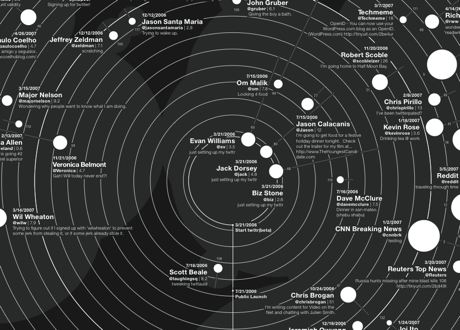Cómo se organiza el mundo de Twitter alrededor de los creadores de contenido más influyentes, la evolución Twitter desde su creación hasta hoy. Todo en un gráfico de 84 x 119 centímetros.
The big bang visualisation of the top 140 Twitter influencers
The Information Architects team have come up with a way of looking at Twitter that echoes maps of how the universe began
Back at the dawn of microblogging time, when Twitter had only just started, there were only three users who mattered: Biz Stone, Evan Williams and Jack Dorsey - the three key people behind the service. Now there are more than a hundred million users - but the key influencers in this huge network can be quite easily identified.
Now the team at Information Architects have decided to come up with a neat Twitter visualisation, akin to The Independent's classic 1992 "How the universe began" graphic, of the top 140 Twitter influencers, "sorted by #name #handle #category #influence #activity" and by when they joined the service (which determines how close to the centre they are).
The size of the blob indicates how many followers; "influence" is measured by... actually, they don't explain, though possibly it's using something like the Twiinfluence algorithm.
Interesting to see who's in there: Stone and Williams, of course, but also latecomer Marissa Mayer (VP of search product and user experience at Google), who only joined in July 2009, and Eric Schmidt, CEO of Google (December 2009) - and of course there's always Bill Gates, who didn't get on board until January 2010. And of course Stephen Fry and indeed Jonathan Ross.
You can get the PDF (1.1MB) or buy it from them for $99 because, as they remark, "we're convinced that our print is way superior to what you can do with your plotter". And you will need a plotter - the graphic is 84cm by 119cm.
We're happy to see that @guardiantech is in there, showing up in something like the place where Kappa Velorum would be in the Milky Way. (We've highlighted it below to help.)
Spot the influencer.. @guardiantech on Twitter
Does this make any difference? Well.. it might do, if this list of the top 140 were made into a list. Anybody up for that, we wonder?


















